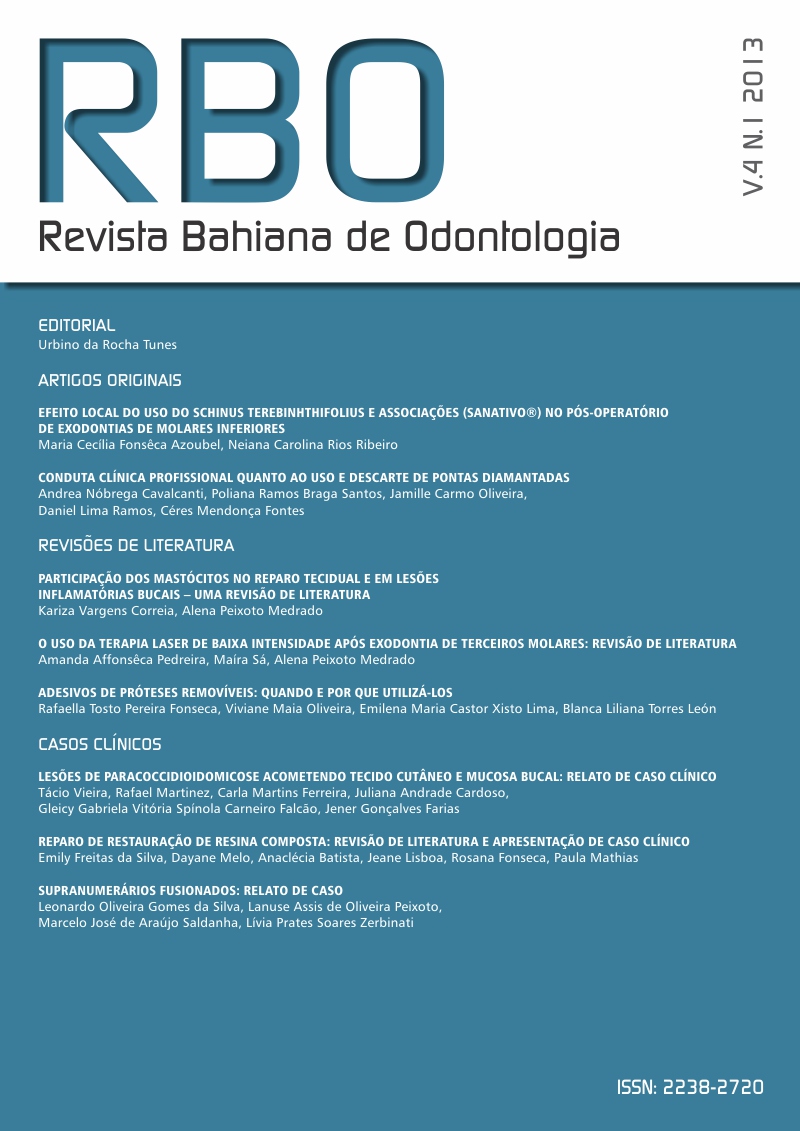REPAIR OF COMPOSITE RESIN RESTORATION: LITERATURE REVIEW AND CASE REPORT
DOI:
https://doi.org/10.17267/2596-3368dentistry.v4i1.118Keywords:
Composite resin.Dental, Restoration repair, Dental restoration failureAbstract
The repair of composite resin restoration is a clinical procedure feasible and allows the removal of the engaged restoration without requiring complete replacement, and thus allowing the conservation of healthy tooth structure. The decision to keep part of the restoration and the clinical protocol of repair should be carefully evaluated and implemented to increase the predictability of the procedure. The bond between the old restoration surface and the composite resin to be added is based on the chemical and mechanical connection between these composites. The micromechanical preparation of the composite in combination with phosphoric acid and the use of fluid resin to improve the wetting of the surface increase the bond strength and efficiency of repair technique between composites. This study aimed to describe the technique of posterior tooth repair, performed in a composite resin restoration, describing the clinical protocol, the advantages and limitations of the technique.
Downloads
References
-Bektas OO, Eren D, Siso SH, Akin GE. Effect of thermocycling on the bond strength of composite resin to bur and laser treated composite resin. Lasers Med Sci. 2012;27(4):723-8.
-Cavalcanti NA, Lavigne C, Fontes CM, Mathias P. Microleakage at the composite-repair interface: effect of different adhesive systems. J Appl Oral Sci. 2004;12(3):219-22.
-Kashi TSJ, Erfan M, Rakhshan V, Aghabaigi N, Tabatabaei FS. An in vitro assessment of the effects of three surface treatments on repair bond strength of aged composites. Oper Dent. 2011;36(6):608-17.
-Maneenut C, Sakoolnamarka R, Tyas MJ. The repair potential of resin composite materials. Dent Mater. 2011;27(2):e20-7.
-Hamano N, Chiang YC, Nyamaa I, Yamaguchi H, Ino S, Hickel R, et al. Effect of different surface treatments on the repair strength of a nanofilled resin-based composite. Dent Mater J. 2011;30(4):537–45.
-Kimyai S, Mohammadi N, Navimipour EJ, Rikhtegaran S. Comparison of the effect of three mechanical surface treatments on the repair bond strength of a laboratory composite. Photomed Laser Surg. 2010;28(2):S25-30.
-Fennis WMM, Kreulen CM, Tezvergil A, Lassila LVJ, Vallittu PK, Creugers NHJ. In vitro repair of fractured fiber-reinforced cusp-replacing composite restorations. Int J Dent. 2011:165938.
-Fernández EM, Martin JA, Angel PA, Mjor IA, Gordan VV, Moncada GA. Survival rate of sealed, refurbished and repaired defective restorations: 4-year follow-up. Braz Dent J. 2011:22(2):134-9.
-Demarco FF, Corrêa MB, Cenci MS, Moraes RR, Opdam NJM. Longevity of posterior composite restorations: Not only a matter of materials. Dent Mater. 2012;28(1):87-101.
-Blum IR, Lynch CD, Wilson NHF. Teaching of the repair of defective composite restorations in Scandinavian dental schools. J Oral Rehabil. 2012;39(3):210-6.
-Tezvergil A, Lassila LV, Vallittu PK. Composite-composite repair bond strength: effect of different adhesion primers. J Dent. 2003;31(8):521-5.
-Araújo RM, Zanet CG, Araújo MAM, Nicolô RD, Rocha JC. Resistência adesiva de reparos em restaurações de resina composta. Pesq Bras Odontoped Clin Integr. 2007;7(2):155-60.
-Sobreira FMSS, Azevedo CR, Freitas Filho LHS, Vidal APV, Barros LF, Ferreira MP. Métodos de reparo em resina composta: uma revisão. Odontologia. Clín.-Científ. 2008;7(2):123-8.
-Ozcan M, Alander P, Vallittu PK, Huvsinans MC, Kalk W. Effect of three surface conditioning methods to improve bond strength of particulate filler resin composites. J Mater Sci Mater Med. 2005;16(1):21-7.
-Staxrud F, Dahl JE. Role of bonding agents in the repair of composite resin restorations. Eur J Oral Sci. 2011;119:316–22.
-Sartori N, Monteiro S, Gondo R, Backer MM. Avaliação da resistência à tração de reparos de restaurações de resina composta. Arquivos em Odontologia. 2010;46(4):190-6.
-Madeira L, Costa EC. Reparo em resina composta indireta: avaliação do tratamento mecânico da superfície. RSBO. 2004;1(1):41-4.



